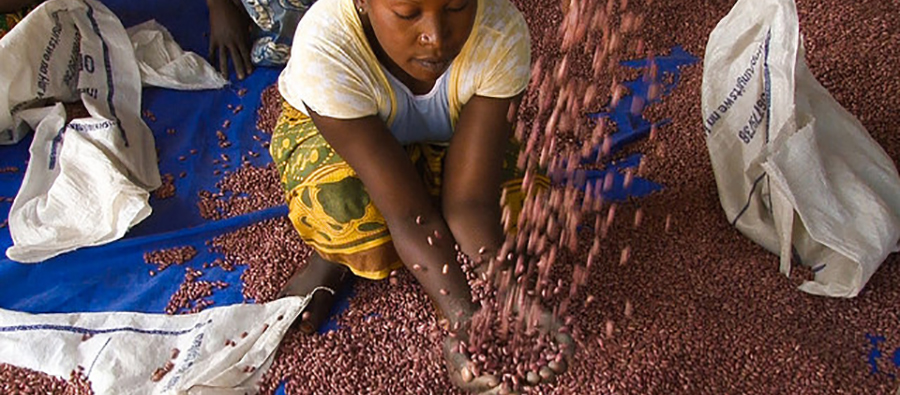After more than a decade of steady decline, world hunger is again on the rise, according to a 2017 report from the UN’s Food and Agriculture Organization. As the need to address growing malnutrition rates grows more pressing, global leaders tackling this challenge must consider engaging in public, private and government partnerships to maximize the reach of critical nutrition programs.
One of the most common forms of malnutrition plaguing the world’s population is micronutrient deficiency, a phenomenon that occurs when people may have enough to eat but lack the micronutrients that are critical to living healthy and productive lives. Currently, micronutrient deficiency, also known as hidden hunger, affects more than 2 billion people worldwide.
The micronutrients most lacking in diets around the world include vitamin A, zinc and iron, according to the World Health Organization. Most frequently, these deficiencies lead to cognitive and physical stunting, blindness, lower resistance to disease, fatigue and even death.
Vitamin A deficiency alone affects 190 million preschool-aged children in rural areas around the globe, 5.2 million of which suffer from night blindness. Meanwhile, zinc deficiency claims the lives of roughly 116,000 a year.
Many African countries are currently endowed with the so-called demographic dividend, a large and growing cohort of young people, estimated at 200 million strong, according to the United Nations. This dividend, if well tapped, has strong potential to bring innovation and energy to Africa’s economy. However, the risk of losing this opportunity is real, with many of the children’s early years threatened by lack of micronutrients needed for body and brain development. Countries cannot take advantage of their demographic dividend if their children are stunted and unable to achieve their full potential.
Affected countries in Asia and Africa see an average annual GDP loss of 11 percent because of the effects of hidden hunger. And worldwide, malnutrition costs the global economy as much as $3.5 trillion USD, or $500 per individual, according to a report from the Global Panel on Agriculture and Food Systems for Nutrition.
One proven solution that is playing an important role in addressing hidden hunger throughout the world is biofortification, an agricultural and technological innovation that draws on conventional breeding processes to boost the levels of micronutrients in staple crops.
The consumption of biofortified foods improves vitamin and mineral levels and is proven to reduce chronic diseases stemming from undernutrition, such as anemia and chronic diarrhea.
In one recent study, young women attending university in Rwanda who consumed daily meals that incorporated high-iron beans experienced complete reversal of their iron deficiency and significant improvement in their cognitive recall in just over four months. Similarly, iron-rich pearl millet reversed iron deficiency in school-aged children in India in only six months.
HarvestPlus, a nonprofit within the CGIAR Research Program on Agriculture for Nutrition and Health, has played a critical role in developing and scaling out biofortified crops, in association with several international research partners. Today, more than 150 varieties of 12 nutrient-rich crops that meet farmers’ demands for yield, quality and climate tolerance are being grown in 60 countries.
Through coordinated efforts among dozens of research institutes, nonprofit organizations, private companies and local country partners, biofortified crops are currently being consumed by 26 million people and are steadily improving nutrition and health around the world. Still, too many people continue to suffer. To ensure that biofortified crops reach people in critical need of micronutrients, HarvestPlus set a goal to reach 1 billion people with biofortified crops by 2030.
Over the next 12 years, the jump from 30 million consumers to 1 billion will require a coordinated effort rooted in ongoing cooperation and the establishment of lasting partnerships between the private, public and government sectors. Luckily, this process is already underway.
Relationships with local country governments have played an instrumental role in reaching rural populations lacking access to foods rich in micronutrients. To date, several countries ranging from Bangladesh to Brazil have incorporated biofortification in their national strategies for reducing malnutrition.
There are now models for how these partnerships can successfully reach farmers and consumers. In Nigeria, the Youth Agripreneurs program works with farmers throughout Africa to provide biofortification training. The program, operated by the International Institute of Tropical Agriculture (IITA) and supported by organizations such as HarvestPlus and others, was initially developed to combat high youth unemployment rates throughout Africa, a challenge that many expect to remain at the forefront in the continent over the next 30 years.
Through the Youth Agripreneur initiative, youth are trained in emerging agribusiness trends —simultaneously tackling unemployment, food and nutrition security. As youth continue to play a growing role in scaling out biofortification, it is likely that their generations will carry on the legacy of biofortification as a valuable tool in the effort to end hidden hunger and as a lucrative investment for farmers.
In addition to scaling out access to improved nutrition, the adoption of biofortification by national governments has given biofortification a stamp of approval as an effective solution to hidden hunger, which has encouraged new private sector investment in bringing biofortified food to more people.
Beyond governmental support, private sector engagement is a critical component of scaling out biofortification. By engaging private companies, such as those that produce seeds or food manufacturers, to use biofortified seeds or crops both farmers and consumers have increased access to biofortified seeds, crops and finished food products.
In Nigeria, biofortified food products have become readily available in supermarkets with the support of companies like Niji-Lukas, a local Nigerian corporation. Niji-Lukas produces vitamin A garri and vitamin A fufu, traditional Nigerian dishes that have been made with biofortified vitamin A maize and are now sold in grocery stores throughout the country. Further developing these types of partnerships will help bring biofortified seeds and products to new markets and expand the reach of biofortification.
National government and private sector support are vital to helping more farmers and consumers access biofortified seeds and crops, but partnerships within the public sector are integral to encouraging farmers to grow biofortified seeds and educating consumers on the benefits of eating biofortified crops. Success with farmers and consumers in these areas is often reliant on training and support schemes.
As the biofortification movement continues to spread it will be vital to engage the private sector as a critical player along the value chain. Working both with SMEs at country level, multinationals around the world while supporting farmers to view farming as a viable business. With more than 30 million people consuming crops across the globe, biofortification is well on its way to becoming a sure pathway to ending hidden hunger.
This post originally appeared on the Chicago Council’s Global Food for Thought blog.



